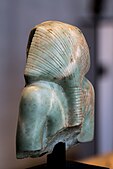Nemes
Appearance
| ||||
| Nemes in hieroglyphs | ||||
|---|---|---|---|---|
Nemes were pieces of striped headcloth worn by pharaohs in ancient Egypt.[1] It covered the whole crown and back of the head and nape of the neck (sometimes also extending a little way down the back) and had lappets, two large flaps which hung down behind the ears and in front of both shoulders.[2] It was sometimes combined with the double crown,[3] as it is on the statues of Ramesses II at Abu Simbel. The earliest depiction of the nemes, along with a uraeus, is the ivory label of Den from the 1st Dynasty. It is not a crown in itself, but still symbolizes the pharaoh's power.
Gallery
-
Upper part of portrait statuette of pharaoh Amenemhat III, wearing a nemes, circa 1853-1805 BC
-
The back an upper part of portrait statuette of pharaoh Amenemhat III, wearing a nemes, circa 1853-1805 BC
-
The golden mask from the mummy of Tutankhamun wearing the nemes, circa 1323 BC
-
Profile of a statuette of Akhenaten wearing a nemes, circa 1351-1332 BC
-
Relief from the Sanctuary of Khonsu Temple depicting Rameses III wearing a nemes
-
Miniature metal nemes
Further reading
- Toby A. H. Wilkinson, Early Dynastic Egypt, Routledge 1999
- Bruce Graham Trigger, Ancient Egypt: A Social History, Cambridge University Press 1983
- Fragment of a basalt Egyptian-style statue of Ptolemy I
References
- ^ Kathryn A. Bard, Encyclopedia of the Archaeology of Ancient Egypt, Routledge 1999, p.412
- ^ Watson Early Mills, Roger Aubrey Bullard, Mercer Dictionary of the Bible, Mercer University Press 1990, p.679
- ^ Max Pol Fouchet, Rescued Treasures of Egypt, McGraw-Hill 1965, p.208
External links
 Media related to Nemes headcloth at Wikimedia Commons
Media related to Nemes headcloth at Wikimedia Commons










